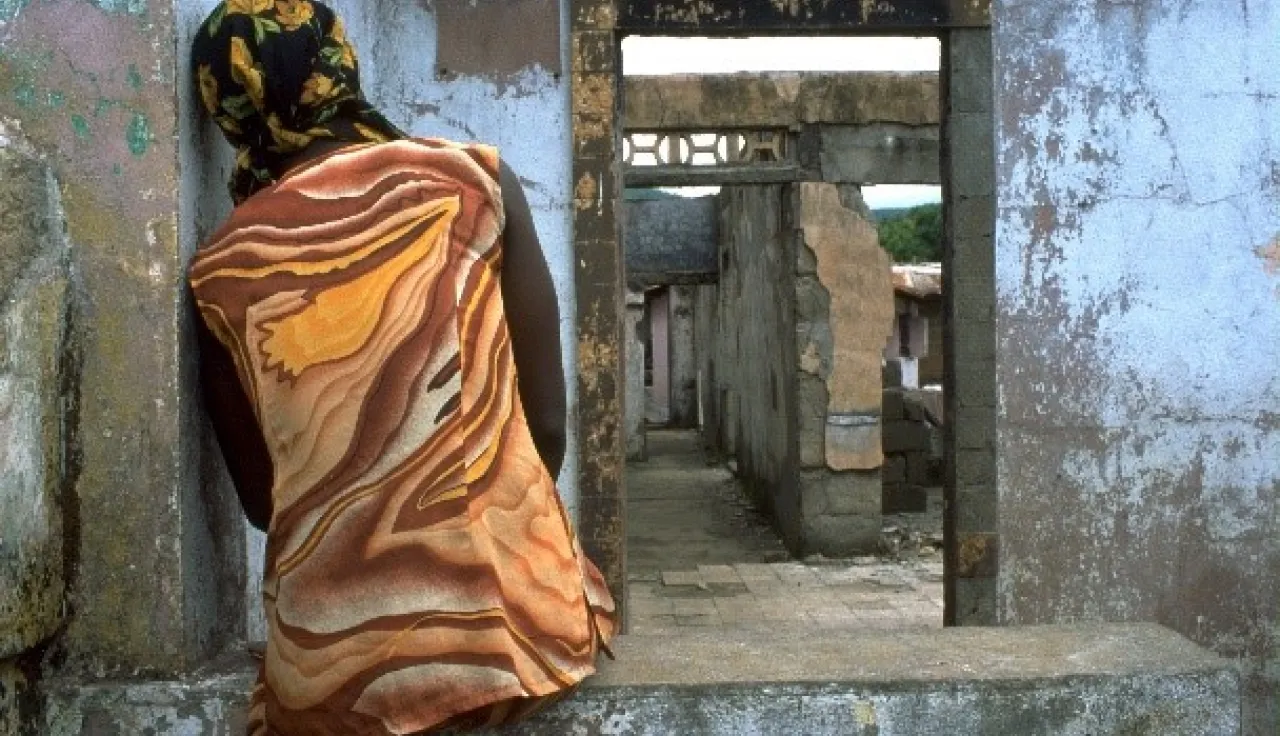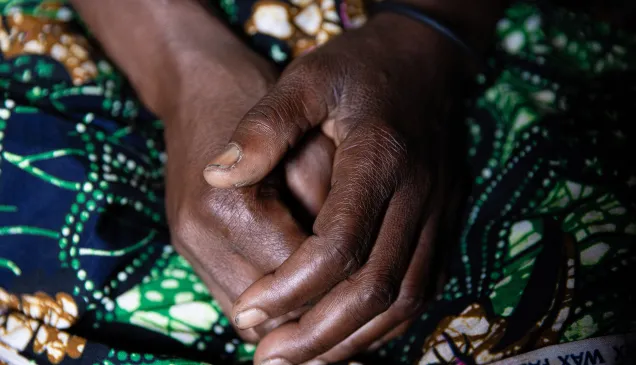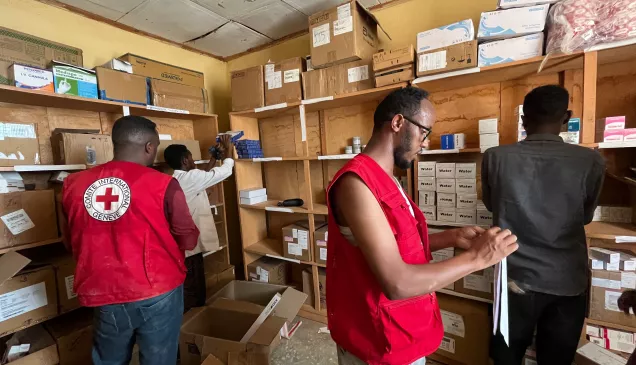The ICRC and the Preventing Sexual Violence Initiative (PSVI)

In November 2016, ICRC director of communications - Charlotte Lindsey, gave a speech to an international gathering of survivors, practitioners and experts looking at the issue of sexual violence. This event took place at Wilton Park in the UK and was hosted and convened by the UK's Foreign and Commonwealth Office and Prime Minister's Special Representative on Preventing Sexual Violence in Conflict, Baroness Anelay.
The focus of the two day meeting was the pervasive problem of stigma when it comes to sexual violence in conflict and what must be done by the international community to try to tackle this issue and provide greater support for survivors. Charlotte's presentation focused on the ICRC's experience of supporting victims of conflict including survivors of sexual violence, the importance of ensuring that any response does not compound the problems of a survivor and a call for better systematic prevention of sexual abuse in conflict in the first instance.
Full Statement by Charlotte Lindsey
When she was 15, Sarah was taken by members of an organized armed group after they killed her father, four of her brothers and her fiancé. While deprived of her liberty, she was subjected to rape, and other forms of ill-treatment. Together with the other girls in the same situation, Sarah was forced to march from one village to another – and forced to carry the heavy possessions of the troops. One day she plucked up the courage to speak to the leader of the group, she said: "Why do you treat me like that?" He replied, "It's better for you this way. See you're still alive. You'd be dead if it wasn't for me." Sarah gave birth to the child of one of the men that had raped her. Some of the girls left their babies behind when they eventually escaped, but she took her daughter, Khadija, with her when she fled. The ICRC encountered Sarah & Khadija in a centre for "former sex slaves" all of whom were underage mothers. Excerpt from book published by ICRC: Eleven Women) Armed conflict is a collective experience, but it is also made up of diverse individual experiences, often of violence and destruction, but also testimonies of resilience and recovery.
In any effort to address sexual violence, it is crucial that we seek to understand individuals, their experiences and perspectives. Let me be clear here: sexual violence, is prohibited, both explicitly and implicitly, under international humanitarian law applicable in armed conflict and, at all times, under international human rights law. It is one of the many violations suffered by not only women and girls, but also men and boys in armed conflict. It is extremely important, when looking at the stigma faced by survivors of sexual violence, that we do not inadvertently "slice their reality" into pieces, that we do not reduce their experience of armed conflict to one particular aspect of their lived experience, and that we seek to address and understand the complexity of the many vulnerabilities they may face.
It is not for anyone to decide whether rape, or another form of sexual violence, is "the worst" experience an individual can have. It is not for us to define the lived reality of armed conflict for them. When we attempt to do this, we may contribute to the very stigma that we are here today to talk about.
Among the many violations committed during armed conflict, sexual violence is one where the stigma is so great that it often results in the victim's rejection by their communities and even by their own families. It is a crime for which victims are blamed and ostracized, while the perpetrators live with impunity.
On behalf of the International Committee of the Red Cross (ICRC), this is a call for action, but also for caution, care and understanding when we work on the very sensitive issue of sexual violence in conflict. We do need to pay special attention to sexual violence, even to look for it, as the injuries, both physical and psychological, may be less obvious than those caused by other forms of violence. We know that victims of sexual violence are less likely to be able to access care, and legal redress, should they choose to pursue this avenue. Therefore, part of our work is to make the invisible, visible.
Caption: "Aminata still suffers from the physical violence she was subjected to during war."
This photo, taken in Sierra Leone in 2001, hangs on the wall of my office. A constant reminder of the need to respect the dignity of survivors of sexual violence, the many risks they face, and the enduring consequences of the violence to which they have been subjected. We made the decision not to show the face of the survivor, Aminata, in order to protect her anonymity from association with a poster that speaks of sexual violence. We know that being associated with such a poster, be it days later, or even years later, can have devastating effects, including stigmatization.
This photo also speaks to one of the many dilemmas faced by survivors; the dilemma of seeking and receiving justice versus facing the consequences of speaking out.
Victims of sexual violence are continually faced with this excruciating choice – to protect their anonymity, keeping what they have suffered to themselves and living with their memories, the effects on their physical and mental health, and potential feelings of guilt or shame, or to seek help and justice and risk being identified, exposed, and stigmatized. We need to respect the decision that a survivor makes in the face of this dilemma.
It is of course essential that victims have recourse to justice, and that perpetrators are held to account. However, we must be aware of the risks survivors face in coming forward to report violations and in seeking redress, and do our utmost to ensure confidentiality is respected at all times.
The risk for victims of sexual violence - be it women, girls, men or boys - who do report such violations to authorities is very real: they are or may be subjected not only to stigmatization, but also to further violence, and even death.Survivors may face "double victimization" when officials and service providers who come into contact with victims are not trained and sensitized, and when there are inadequate frameworks which do not include confidential procedures for victims who seek help.
We therefore must act to mitigate the issue of stigmatization and misperception among service providers themselves through technical training and capacity building. Medical staff, including those who work in places of detention, must be trained to be aware of the signs of sexual violence and of the importance of maintaining medical confidentiality. They need to know and be reminded of their responsibilities to survivors of sexual violence so that they do not in any way contribute to their further victimization.
Another area of concern that we are looking into through specific operational research, are laws that may, in effect, stigmatize and hamper a victim's access to necessary services, particularly health care. Survivors might be, for example, required to report to the police before they are permitted access to care. It could also be the case that service providers may be required – or perceive that they are required – to report to police before or after they care for a victim of sexual violence. Such requirements could have serious consequences as they may constitute a significant obstacle to care. It is often the particular stigma that sexual violence carries, which prevents victims from talking about what has happened to them. Those they may go to for help may not only further victimize the victim, they may even sexually violate them.
Moreover, in some countries there may be a lack of legal and administrative recognition for children born of rape, which then exacerbates survivor's stigmatization and hinders their inclusion into society.Another consideration related to stigma has to do with how we, as operational actors, respond to sexual violence.Organizations such as the ICRC have a role to play both in supporting survivors to deal with stigma while at the same time ensuring that we do nothing that might further stigmatize or harm victims through our interventions. The ICRC's approach is needs-based: we tailor our humanitarian response to the needs of victims – women, men, boys and girls - and communities. The ICRC's way of working centers around discretion in order to ensure we have access to all those affected by the consequences of armed conflict and those who can influence the conduct of hostilities, including members of the armed forces or armed groups.
By providing medical care as part of a broader emergency health care approach that benefits the general population and victims of all types of violence, we seek to ensure that survivor's of sexual violence can have access to services, and that we avoid labelling and stigmatizing victims of sexual violence through our very programme/ response.
Therefore, it is important to frame and offer services for survivors of sexual violence in an inclusive way (e.g. within primary health care programs targeting all vulnerable groups in a given region). We work to ensure acontinuum of care, as victims of sexual violence suffer not only physical but also psychological wounds. Therefore, our approaches need to be multi-disciplinary, for example, mental health support as well as medical care to prevent/treat sexually transmitted diseases. Dealing after the fact with the consequences of sexual violence is only part of our work. We must also work to prevent sexual violence. Thus a crucial aspect of our approach, which is again linked to the stigma of sexual violence, is our work with at-risk communities to reduce exposure to sexual violence, and to provide alternatives to harmful coping strategies, such as micro-economic initiatives, cash assistance programs, and access to work and information. Wherever possible, we base our activities on the capacities of communities and reinforce existing constructive coping mechanisms. Other risk reduction measures include the installation or repairing of water points closer to communities so as to reduce risk of sexual violence faced by women and girls when collecting water.
Community leaders, including religious leaders, and civil society, play an important role in raising awareness among the wider population of the need to prevent sexual violence from happening and to protect victims of sexual violence, including against further victimization and stigmatization. Next week, the ICRC is launching People on War, the results of an opinion poll carried out this year in 16 countries including some 10 countries which are affected by armed conflict. People on War asked important questions on awareness and respect of International Humanitarian Law. The results highlight the importance for those in countries experiencing armed conflict of community leaders, religious leaders and military leaders in influencing behaviour of combatants in times of war. Training and instruction for members of the armed forces and armed groups is a very important task carried out by the ICRC, and highlighting that sexual violence is prohibited is critical.
Lastly, detainees are a community at risk and stigma is among the multiple barriers which they face. Stigma is also an obstacle in our collective efforts to stop sexual violence perpetrated against detainees, and ensuring their access to care. Interrogation centres present a particular risk of sexual violence that may amount to torture, but detained men, women, boys, and girls also face the risk of sexual violence in other places of detention, perpetrated by the detaining authorities or by other detainees. It is primarily the responsibility of the detaining authorities to provide protection from this violence, but the ICRC's working practices when visiting detainees can help them to do so. We examine the facilities for danger points, talk to detainees in confidence and try to prevent retribution by repeating our visits. We also work with the authorities to try to change practices and to reduce risk also through concrete steps such as improving lighting, facilitating separation of adults from minors and women from men (when these are not family members), and ensuring equitable access to the most basic necessities.
The readiness of donors to fund programs on sexual violence is positive, as this remains an underfunded sector despite increased international attention. However, we at the ICRC feel strongly that this must not translate into a practice of singling out and therefore exposing victims of sexual violence in our activities. In terms of the allocation of funding therefore, it is important to be mindful of the potentially harmful consequences arising as well through funding practices.
To conclude, I would like to return to Sarah and Khadija. Over a decade later, she is married, and has a second child. It took her husband's family years to accept her and her first daughter, but they did give their blessing. Sarah was promised reparations, but has received nothing. Yet they are managing to build a fragile happiness. She still can't return to her village, even though her mother is still there. The feeling of shame is still far too raw. Is this an exceptional story? Yes, it is an exceptional story of resilience and of individual coping mechanisms, but it also tells us a lot about stigma.
The issue of stigma, and its many facets, faced by victims of sexual violence everywhere, should not be left in the abstract. It is not simple, nor one dimensional. Stigma affects survivors of sexual violence in a multitude of ways, and there cannot be a one size fits all solution. For all of us who seek to contribute to addressing the issue of sexual violence, a commitment to "doing no harm" must be at the center of our endeavours. We must always come back to the best interests and safety of the individual survivor.



